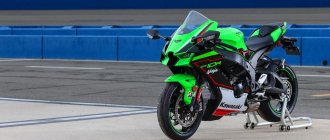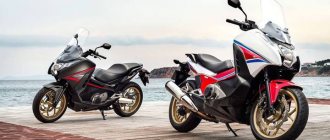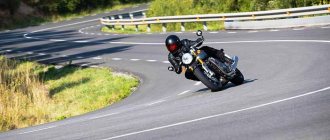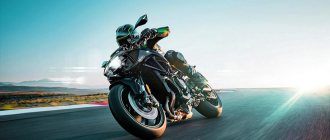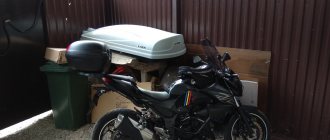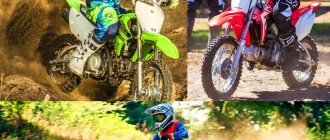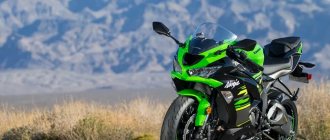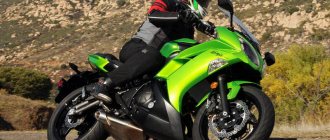Kawasaki Ninja 400 delivers more punch, less weight and a new feel
The new Kawasaki Ninja 400 has a big task ahead of it. Not because it evokes memories of the evil 400s of the early 90s, which, by the way, it copes with thanks to Euro 4, but also because of the previous, excellent Ninja 300, which needs to be surpassed. The new product from Kawasaki is designed to serve as an entry ticket to the world of motorcycle racing with power, flexibility and various bells and whistles.
Test drive: Kawasaki Ninja 400 2018
On paper, everything is fine: more power (+5 hp), less weight (-6.6 kg). Plus, it has a fantastic appearance, partly borrowed from: aggression in design, “shark nose”, sophisticated tail.
Although this is an entry-level racing sportbike, the riding position is a bit conservative, with the pegs set further forward than you might expect. The clip-ons, although now located lower, are still located above the usual level of clip-ons on such equipment. The low 785 mm saddle was left untouched, which, by the way, is good news for short and novice riders. The result is a neutral landing with good visibility and comfort, as far as this word is applicable here.
399cc Kawasaki Ninja engine
But what's really important about the new Kawasaki Ninja is its new 399cc engine, which is the reason the motorcycle was created. Along with the new cubic centimeters comes an increase in power - 44.3 hp. and 28 moments (versus 39 and 19, respectively).
The bike feels great at 6,000 rpm, but push it past 10,000 rpm and the power, excitement and rich exhaust note will leave you grinning.
Naturally, there is no such power here that would make the motorcycle fly out of your hands. But driving at rpms above 7000 brings a lot of emotions. The power is delivered in sufficient quantities for overtaking and comfortable driving on highways at high speed limits. Also, despite the fact that the engine is very rigidly attached to the frame, the vibration from it is so small that sometimes you want to rev the throttle just to check if the motorcycle is working at all.
Since the cubic capacity is low, the gearbox clicks constantly. The updated gearbox is good, and the slipper clutch makes life easier on gear drops.
For whom
This motorcycle is probably suitable for those who do not need high speed at all, but are attracted by something sporty in the exterior of the bike. If you like modern, stylish two-wheeled motorcycles, but only need to get around the city, there can hardly be a better option than this naked bike.
The main advantages of the Kawasaki EP-4 are:
- stylish appearance to match its class;
- good data, making him one of the fastest in the class;
- balance of elements and ride comfort.
The Kawasaki ER-4 is the embodiment of design genius, because there is not a single detail in the exterior of the car that one could find fault with. You can hardly find a better bike if you want to ride a beautiful and powerful motorcycle in the city.
Kawasaki Ninja 400 suspension
Although the Kawasaki Ninja 400 suspension is non-adjustable (with the exception of rear preload) , this is not particularly scary, since the adjustment comes from the factory. The fork has become fatter from 37mm to 41mm and feels great in city driving. The bike's excellent overall balance is achieved through a new tubular frame that is closely intertwined with the engine, as well as a swingarm integrated directly into the same frame. No extra weight, the design is somewhat similar to the flagship Ninja H2.
Specifications
In terms of its technical parameters, the motorcycle is ahead of many representatives of its class. It's capable of delivering the power and speed of a sports bike rather than a naked bike like this.
The model is also good because all the components fit perfectly together and there is no disharmony between them. A moderately powerful engine, a well-chosen transmission, appropriate brakes and chassis - the EP-4 has it all.
Brakes Kawasaki Ninja 400
The Kawasaki Ninja 400 brakes have also been updated. New Nissin caliper, new, stiffer brake machine with a 20mm cylinder, larger single brake disc (as if removed from the ZZR1400). All this together has a braking force that stops the motorcycle even when you lightly press the lever. At the same time, the lever retains its information content and allows you to evaluate light alloy wheels. The rear brake is as effective as required. The model is equipped with ABS.
Dimensions and weight
The bike's curb weight is 199 kilograms, but if ABS is built into the model, the weight will be 203 kilograms. This is a relatively small difference. Quite weighty, but not too heavy. This is how a city bike should be.
The length of the bike reaches 2100 millimeters. This is the average setting; Both city bikes and cruisers, as well as sports motorcycles, can have this length. Its width is 760 millimeters and its height is 1100 millimeters. The height of the motorcycle at the saddle is 785 millimeters.
The tank capacity reaches 15 liters. The bike consumes only 2.66 liters of fuel per 100 kilometers of road, which means you can ride as much as 500 kilometers without refilling, which is impressive. The dimensions meet the needs of the target audience of this model and the class of motorcycles as a whole.
After riding the Kawasaki Ninja 400
But there are a couple of places where you can find fault: after riding the Kawasaki Ninja 400 for 150 kilometers, the seat begins to feel hard. Despite the fact that the exhaust is mounted directly under the right heel, burns cannot occur thanks to the heat shield. However, a rider with a foot size of 44 and above may have some discomfort when transferring their foot on the footboard to the toe.
But the overall success of the Kawasaki Ninja 400 lies in the intuitiveness of the bike. It goes exactly where you want it to go, brakes and stops exactly where you want it to go. Combine that with style and practicality, and you've got a combo that suits both beginners and those looking for an entry-level sport bike. Work is done!
Old or new? Kawasaki ZXR-400 or Ninja 400? Inexpensive rockets
Kawasaki ZXR-400
The Kawasaki ZXR-400 debuted 30 years ago and became a hit in the Japanese market. In Russia, it was loved for its maneuverability and great power. Today Ninja 400 is back. How much has he changed?
The ZXR 400, which debuted in 1989, was a unique motorcycle in its day. On the roads (of the world, but not of Russia), motorbikes of the 750 (GSX-R or ZXR 750) and 1000 (FZR) classes ruled the roost. The time of the six hundredths was still ahead. In the late 1980s, similar models appeared on the market - 250-400 racing models (for example, VFR 400 R), for which the Japanese participated in national championships. Due to their relatively high prices, these motorcycles were mainly popular in Europe.
However, over the years, many used motorcycles have been shipped to Europe. Today they are a delight for sporty driving enthusiasts because the ZXR 400 is cheap, tough to handle, and yet has a sporty character that, despite the passing of years, still succeeds.
In 2003, production of a sports four-cylinder “rocket” with a 400 cm3 engine was completed. Years later, Kawasaki returned to the idea of small-volume sports. First it was “250”, then “300”, and this year “400” debuted. What is the difference between the latter and its ancestor?
The most important difference is that the assumption behind the two machines is different. The ZXR 400 was designed to be a race car - fully equipped, fast, but also expensive. The Ninja 400 is a relatively inexpensive motorcycle and not very complex, but with significant sporting potential, so the amateur will have a great time, and the professional will get more than he expects.
The Ninja 400 is a slightly simplified motorcycle. It's reminiscent of the top-of-the-line ZX-10R, but has a tubular steel frame, traditional forks and single-disc brakes. The engine is in-line two-cylinder.
The ZXR 400's sporting ambitions are evident in every detail. Its front pivot is an inverted fork, and the brakes are two discs at the front and one at the rear with four-piston calipers. Frame: dorsal, made of aluminum. The engine is, finally, a four-stroke with a short stroke. In total, this is a miniature of the ZXR 750, which was then the pinnacle of sports motorcycles. The engine likes to rev high (up to 14,500 rpm) and already offered plenty of power in the production version. Performance from 65 to 68 hp. with a volume of 400 cubic meters. cm is impressive even today - from 162.5 to 172 hp! In the early 90s it was a sensation. Even good bikes could then squeeze out no more than 80 hp.
Kawasaki ZXR-400
The engine of the new Ninja 400 is designed differently. Liquid-cooled twin-cylinder heart producing 48 hp. Enough to make the ride enjoyable, it is also easy to handle for a motorcyclist with an A2 license. Its strong points are linear power, versatility, durability and low price.
Just as the technology of the models differs, so does the behavior of the engines. The two-cylinder engine is fast and quiet. The four-cylinder engine is more demanding and expressive. The 4-cylinder requires a long rotation of the starter, but, as I said, it sounds like music. On the Ninji 400, you can engage the clutch with one finger, stick the unit into the slightly working box and drive away. The ZXR 400 has a stiff clutch lever, and the unit's clatter is accompanied by a pronounced touch. To drive, you need to crank the engine to at least medium speed. Dynamic riding on the ZXR 400 doesn't come easy. You need to learn to ride this motorcycle.
The Ninja 400 doesn't have as much power as the ZXR 400, but has a strong midrange and a significantly downsized Chinese engine than the ZXR 400. It weighs 16kg less than the ZXR, has narrower tires and offers a more upright position at the helm. Softly shock-absorbing suspensions provide comfort and good control over the situation. After turns, the Ninja is lively, active but free, and rarely requires the engine to rev quickly or brake hard before the next turn.
And the ZXR 400 forces you to do this. Between 6,000 and 10,000 rpm - the mid-range in this car - there is good flexibility, but the wings only develop higher. The engine instantly revs to 14,000 rpm and after a short run on the highway reaches almost 220 km/h. It's too fast for the Ninja 400.
Kawasaki ZXR-400
The ZXR 400 is more demanding in corners, but also has more capability. It was felt that where the suppression of the Ninja reached its limits, it was just beginning. It becomes clear why the suspensions are rigidly tuned and have such dimensions. The accuracy of guidance and forward feedback are still pleasing today, but the reserve... is still great!
The ZXR has a poor driving position: the sofa is too low, the footrests are too high (this requires high ground clearance when folded), i.e. the bike is aggressive... but also uncomfortable. However, this is a low price to pay for a piece of Kawasaki racing history that, despite 30 years, is still impressive. If after this text you don’t think for even a minute that it would be nice to have a ZXR-400 in the garage, then something is wrong with you!
Post Views: 4,039
Similar articles:
No similar
